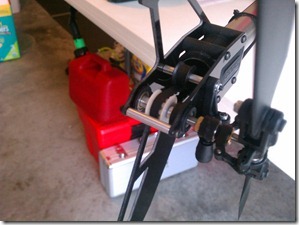Well hello there, its been a few weeks since I posted any updates on the Radikal so I figured I’d catch you up. So far I have run a gallon of fuel through the helicopter and it is flying like a dream. I noticed a bit of dirty grease coming out of of the tail rotor bearings so I decided it wouldn’t hurt to do a tear down and inspect everything. While I did the tear down, I went ahead and simplified the electrical system and I ran it inside the helicopter so it would look cleaner. I also got rid of most of the wire ties that were holding cable bundles together and replaced them with Velcro tape. What I’ve learned so far is that vibration is normal for gasoline-powered helicopters and it must be dealt with accordingly. Here are a few tips:
- Use Velcro tape instead of zip ties to keep cables together
- Anywhere that any cables will be interfacing with the frame, insulate with rubber tape, fuel tubing, or an equivalent.
- Mount electronics on foam tape, self-adhesive Velcro strips (my preference), or anything else that will insulate from the vibration. The natural vibration can cause board components to come loose over time.
These tips should help you keep your electronics in good shape and ensure you have a long, enjoyable experience flying a gasoline-powered helicopter like the Radikal G20. I’ve included a picture of my spark plug below to demonstrate what I “think” the plug should look like on a slightly rich engine. The plug isn’t quite the chocolate brown that everyone I’ve asked spoke of but it has a slight darkness to it that leads me to believe it is still rich. I’m not going for high-performance so I’m ok with the engine running a little bit rich. The condition I want to avoid like the plague is a lean run since that can destroy the engine pretty quickly. While on the topic of engines, I had a conversation with Al at BH Hanson and I think I’m going to send him my engine later on this year for a full balance. I’d love to have it run smoother!

The tail rotor got a full cleaning, belt adjustment, bearing inspection, and thread locker for bolts all around. I think the excess grease from the bearings was pushed out through normal operation. It is nice to see all of this clean again and looking like new!
In addition to all of the cleaning, adjusting, and inspecting, I also installed an exhaust deflector using silicone tubing and a copper elbow. I also finished putting all the decals on the canopy to add a little bit of pizzazz!
When the electronics were relocated, I moved the GV-1 governor to the gas tank side so I could still make adjustments to it and see it when starting the engine.
The final modification was a Dean’s plug “switch” at the rear of the helicopter, allowing me to fire and kill the electronics without removing the canopy!
And finally, the fleet!





